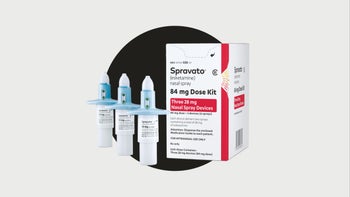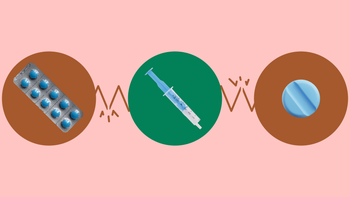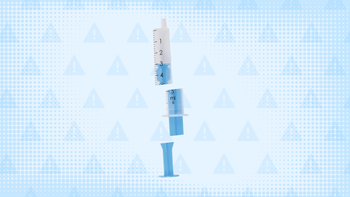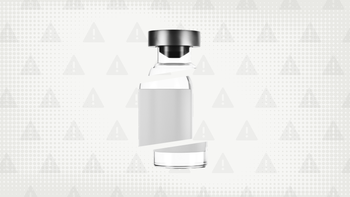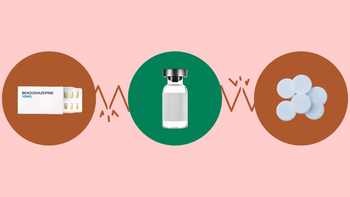
LSD and Mental Health: Research & Future Treatments
Key takeaways:
LSD is a psychedelic drug that causes changes in mood and perception.
When combined with therapy, LSD has shown promise for treating several mental health conditions, like addiction, depression, and anxiety.
LSD is illegal in the U.S. It is only available in clinical trial settings.
In the future, it’s possible that LSD may become an approved treatment option for certain mental health conditions.
Table of contents
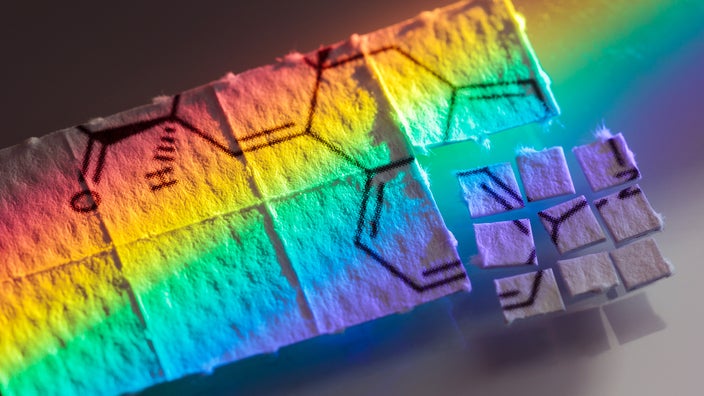
For many people, LSD (lysergic acid diethylamide, or “acid”) is a psychedelic drug often associated with the counterculture of the 1960s. But it has a longer history than some people may realize. LSD was accidentally discovered by a Swiss chemist named Albert Hofmann in 1943. The drug comes from a natural compound in ergot, a fungus found in rye and barley.
In the mid-20th century, LSD was used as a treatment for some mental health conditions. Back then, therapists and psychiatrists developed the practice of LSD-assisted therapy to help thousands of people with problems like depression, anxiety, and substance use disorders.
But as time went on, people began to worry about LSD’s recreational use. The rules for researching it became stricter. And by the 1970s, LSD actually became illegal in the U.S.
Even though LSD is still illegal in the U.S. today, clinical research with psychedelics in the U.S. began again in the early 1990s. The first study to use LSD in the modern wave of research wasn’t published until 2014. This study explored the benefits of LSD-assisted therapy on anxiety from life-threatening illnesses. Today, many new research studies are underway.
How does LSD work?
We’re still learning how LSD works. It seems to affect your body and brain in many different ways, including:
Serotonin: Serotonin is a chemical in your body that plays a role in mood and conditions like depression, anxiety, and obesity. LSD is a “serotonergic psychedelic” that interacts with serotonin receptors in your body.
Hormones: Unlike other psychedelics, LSD also affects a neurotransmitter and hormone called dopamine. Dopamine regulates the way you process pleasure and reward. It is linked to conditions like depression and addiction. LSD also increases hormones like oxytocin and cortisol, which are important regulators of stress and mood.
Communication in the brain: Brain imaging shows that LSD may make it easier for different areas of the brain to communicate with each other.
Neuroplasticity: LSD and other psychedelics may encourage neuroplasticity. Neuroplasticity is your brain’s ability to grow and change. It may be one of the ways people adapt to new situations, stress, injuries, and other environmental changes.
What are the psychological effects of LSD?
Just like the physical effects of LSD on the body and brain, we’re still learning about the mental effects of LSD. Here’s some of what we know so far about how it affects mood, thinking, and emotions:
Changing emotions: When people use LSD, they can experience many different emotions. These can range from extreme happiness to anxiety and paranoia.
Perceptual changes: LSD can cause visual changes like seeing brighter colors or distorted shapes and sizes. It can also make sounds louder or different. When people use LSD, it can also change their sense of time and space, or their perception of themselves and others.
Self-reflection: For some people, LSD can bring up unconscious or forgotten thoughts, feelings, and memories.
More sociability and empathy: LSD also appears to increase feelings of empathy, trust, and desire to be around other people.
Mystical experiences: Many people report having a mystical or spiritual experience when using LSD. Some people also describe a sense of awe, happiness, and togetherness with the universe. In some research studies, having mystical experiences during psychedelic therapy is linked to longer-lasting benefits.
What is LSD-assisted therapy?
LSD-assisted therapy is a type of talk therapy that involves the use of LSD. It’s different from recreational use because a doctor or other healthcare provider is present.
LSD-assisted therapy often involves a series of different types of therapy sessions. Here’s how these typically run.
Preparation sessions
These sessions help the participant get ready to take LSD. These may include:
Medical screening
Meeting and building a trusting relationship with therapists
Creating a safe physical and mental environment
Setting therapy goals
Learning about what to expect during the LSD sessions
Learning about the possible risks and side effects of taking LSD
LSD therapy sessions
During the LSD therapy sessions, patients take a dose of LSD under the supervision of a psychiatrist, therapist, or other healthcare professional. After taking LSD, people often lie down in a comfortable environment and listen to music. Therapists are present to keep the participant safe and to listen to and support the patient.
Integration sessions
These sessions take place after the LSD-assisted session. They’re called “integration sessions” because they can help people make sense of their LSD experiences and insights and integrate them into their life.
What conditions is LSD being used to treat?
Right now, LSD isn’t approved for treating any health conditions. But researchers are investigating many possible uses for LSD-assisted therapy.
Let’s take a look at some of the most promising areas.
Substance use disorders
In the past, LSD-therapy was used to treat substance use disorders, especially alcohol use disorder. There’s some evidence that when it comes to alcohol dependence, even a single LSD-therapy session could work as well as other medications.
There are several theories of how LSD works in addiction. LSD might be able to:
Directly influence addictive thoughts and behaviors through its effects in the brain
Help people better understand their addiction
Provide a spiritual experience that encourages long-term lifestyle changes
Depression
Depression is a common mental illness. Current treatment options like psychotherapy and antidepressant medications can help, but they’re not always effective. There’s some evidence that LSD could have antidepressant effects in people with depression.
In the past, many psychologists noticed that LSD had antidepressant benefits. But most of the modern research has focused on another psychedelic called psilocybin (magic mushrooms), due to its similar but shorter-lasting effects than LSD.
Anxiety
There’s also some evidence that LSD may help with anxiety — especially for people with anxiety related to a life-threatening illness. In the past, LSD was helpful for terminally-ill patients. It has helped many people face their fear of death, which reduces anxiety and depression. In some research studies, LSD has helped to reduce anxiety for up to 12 months in terminally-ill patients.
LSD-assisted therapy may also be helpful for healthy people with anxiety, too. In some studies, people with anxiety felt better for up to 4 months after treatment with LSD. But keep in mind: Some patients actually had a temporary increase in anxiety during treatment.
What are the risks of using LSD?
When used in a research setting, LSD appears to be mostly safe, with relatively few negative effects. The National Institutes of Health (NIH) also says there’s no evidence that LSD causes organ or brain damage, even at high doses.
But that doesn’t mean that LSD is completely risk-free, especially if used recreationally. For some people, taking LSD can be a negative or scary experience (called having a “bad trip”).
LSD can also cause unpleasant side effects like:
Increased heart rate or blood pressure
High body temperature
Trouble sleeping
Appetite loss
Chills or sweating
Tremors
Dry mouth
Anxiety or panic attacks
Psychedelics — including LSD — can also cause a rare condition called hallucinogen persisting perception disorder (HPPD). HPPD is a condition where the perception changes (known as flashbacks) continue even after the drugs have worn off.
What is microdosing LSD, and is it safe?
Microdosing is a current trend where people take a very small amount of a psychedelic drug, often LSD or psilocybin. People who microdose say they use it for several reasons, like:
Reducing depression and anxiety
Enhancing concentration and/or creativity
Boosting psychological and social well-being
But the truth is: There’s just not enough evidence yet to say whether microdosing has any health benefits, or if it’s even safe. Some people also report problems from microdosing, like:
Problems with thinking
Low energy
Low mood
More anxiety
Headaches
Upset stomach
More research is needed before we can understand the effects of microdosing LSD.
The bottom line
LSD has a long history of use in psychotherapy. It has shown promise for a variety of mental health conditions, especially substance use disorders. But currently, it is illegal and not an available treatment outside of clinical research. As the practice of psychedelic-assisted therapy regains attention, we are learning more about how LSD may renew mental health care. Until then, you can learn more about ongoing clinical trials by visiting psychedelic.support for a directory of psychedelic-AT trials.
References
Abramson, H. (1967). The use of LSD in psychotherapy and alcoholism. The Bobbs-Merrill Company, Inc.
Barrett, F., et al. (2018). Classic hallucinogens and mystical experiences: Phenomenology and neural correlates. Current Topics in Behavioral Neurosciences.
Belouin, S., et al. (2018). Psychedelics: Where we are now, why we got here, what we must do. Neuropharmacology.
Bonson, K. (2018). Regulation of human research with LSD in the United States (1949-1987). Psychopharmacology.
Canal, C. E. (2018). Serotonergic psychedelics: Experimental approaches for assessing mechanisms of action. Handbook of Experimental Pharmacology.
Dolder, P., et al. (2016). LSD acutely impairs fear recognition and enhances emotional empathy and sociality. Neuropsychopharmacology.
Dyck, E. (2005). Flashback: Psychiatric experimentation with LSD in historical perspective. Canadian Journal of Psychiatry.
Fuentes, J. J., et al. (2020). Therapeutic use of LSD in psychiatry: A systematic review of randomized-controlled clinical trials. Frontiers in Psychiatry.
Galvão-Coelho, N. L., et al. (2021). Classic serotonergic psychedelics for mood and depressive symptoms: A meta-analysis of mood disorder patients and healthy participants. Psychopharmacology.
Gasser, P., et al. (2014). Safety and efficacy of lysergic acid diethylamide-assisted psychotherapy for anxiety associated with life-threatening diseases. The Journal of Nervous and Mental Disease.
Giacomelli, S., et al. (1998). Lysergic acid diethylamide (LSD) is a partial agonist of D2 dopaminergic receptors and it potentiates dopamine-mediated prolactin secretion in lactotrophs in vitro. Life Sciences.
Grof, S. (1975). Realms of human unconscious: Observations from LSD research. Viking Press.
Grof, S., et al. (1973). LSD-assisted psychotherapy in patients with terminal cancer. International Pharmacopsychiatry.
Hofmann, A. (1980). LSD — My problem child. McGraw-Hill.
Holze, F., et al. (2022). Lysergic acid diethylamide — Assisted therapy in patients with anxiety with and without a life-threatening illness: A randomized, double-blind, placebo-controlled Phase II study. Biological Psychology.
Holze, F., et al. (2022). Safety pharmacology of acute LSD administration in healthy subjects. Psychopharmacology.
Hwang, K., et al. (2022). Lysergic acid diethylamide (LSD). StatPearls.
Johnson, M., et al. (2008). Human hallucinogen research: Guidelines for safety. Journal of Psychopharmacology.
Kaelen, M., et al. (2018). The hidden therapist: Evidence for a central role of music in psychedelic therapy. Psychopharmacology.
Ko, K., et al. (2022). Psychedelics, mystical experience, and therapeutic efficacy: A systematic review. Frontiers in Psychiatry.
Krebs, T. S., et al. (2012). Lysergic acid diethylamide (LSD) for alcoholism: Meta-analysis of randomized controlled trials. Journal of Psychopharmacology.
Lea, T., et al. (2020). Psychedelic microdosing: A subreddit analysis. Journal of Psychoactive Drugs.
Liechti, M. E. (2017). Modern clinical research on LSD. Neuropsychopharmacology.
Liester, M. B. (2014). A review of lysergic acid diethylamide (LSD) in the treatment of addictions: Historical perspectives and future prospects. Current Drug Abuse Reviews.
Ly, C., et al. (2018). Psychedelics promote structural and functional neural plasticity. Cell Reports.
Martinotti, G., et al. (2018). Hallucinogen persisting perception disorder: Etiology, clinical features, and therapeutic perspectives. Brain Sciences.
Murphy, R., et al. (2021). MDLSD: Study protocol for a randomized, double-masked, placebo-controlled trial of repeated microdoses of LSD in healthy volunteers. Trials.
Pahnke, W., et al. (1970). The experimental use of psychedelic (LSD) psychotherapy. JAMA.
Rosenbaum, D., et al. (2020). Microdosing psychedelics: Demographics, practices, and psychiatric comorbidities. Journal of Psychopharmacology.
Rucker, J. J., et al. (2018). Psychiatry & the psychedelic drugs. Past, present & future. Neuropharmacology.
Schmid, Y., et al. (2015). Acute effects of lysergic acid diethylamide in healthy subjects. Biological Psychiatry.
Singleton, S., et al. (2022). Receptor-informed network control theory links LSD and psilocybin to a flattening of the brain’s control energy landscape. Nature Communications.
U.S. Department of Justice/Drug Enforcement Administration. (2020). Drug Fact Sheet: LSD.



